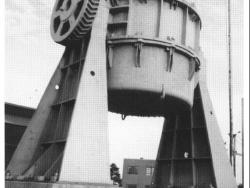The concept of once-over mechanical, as opposed to multiple-pick hand or experimental multiple-pick machine harvesting, represented a major break-through in the practice of producing vine fruit such as pickling cucumbers. In the 1950s the cost of hand harvesting was as high as 50% of the production cost. Once-over mechanical harvesting, coupled with increasing plant population, reduced this cost to 25% thereby making production economically viable.
USA

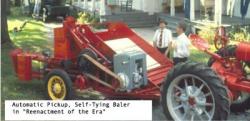
This machine is the world's first successful automatic pickup, self-tying hay baler. Its invention was a significant contribution to the development of American Agriculture. The baler was invented and hand-built in 1937 at Farmersville, Pa., a few miles from here. After testing and improvement, some production models were made at Kinzers, Pa. Balers of this type were first mass-produced in 1940 by the New Holland Machine Company. Dedicated by American Society of Agricultural Engineers 1976
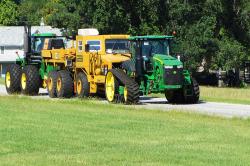
The First Official Nebraska Tractor Test was Started in this Building March 31, 1920. These Pioneer Tests Became Worldwide Standards and are Recognized by The American Society of Agricultural Engineers as an Historic Landmark of Agricultural Engineering. 1980
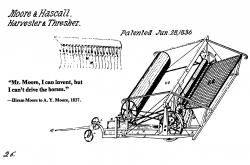
A Historic Landmark of Agricultural Engineering in 1834 Near the Village of Climax, Michigan, Hiram Moore and John Hascall Built and Put Into Practical Use the First Successful Grain Combined Harvester - Thresher Which was Patented June 28, 1836. This Achievement was a Significant Contribution to the Development of American Agriculture Dedicated by the American Society of Agricultural Engineers 1978
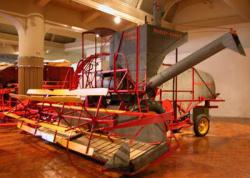
Designated A Historic Landmark Of Agricultural Engineering The Massey-Harris No. 20 was the First Commercially- Successful Self-Propelled Combine Used to Harvest Small Grains Under a Wide Variety of Conditions, World-Wide. Engineered By Thomas Carroll, Chief Engineer, Aided by Robert Ashton and Albert Luke, Principal Assistants, it was First Marketed in 1938 by the Massey-Harris Company. This Combine Opened a New Era an Farm Mechanization and Revolutionized the Grain Harvesting Process. Forty-Four Years Later, This Same Harvesting Principle Continues to be Used Throughout the World.
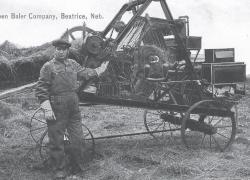
Luebben Hay Baler - Historic Landmark of Agricultural Engineering. In 1892, Hugh Luebben from Sutton, Nebraska, with sons Melchior and Ummo built a mobile machine to produce round hay bales between two sets of rotating flat belts. They began manufacturing the baler in 1909 in Beatrice and later moved to Omaha, Nebraska. Allis-Chalmers purchased the patent in 1939 and eventually sold 77,200 "Roto-Balers." The Luebben baler made handling easier, improved hay quality, and reduced costs. The same basic design is used on modern large round balers.
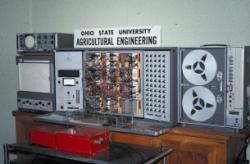
The first laser grade control was developed by agricultural engineers James Fouss and Norman Fausey of USDA's Agricultural Research Service at The Ohio State University in the mid-1960's. That system controlled the precise depth and grade of subsurface drains by regulating trenching and plow-type drainage machines. Photo cells mounted on the drainage machine automatically raised and lowered the digging device, keeping the cells centered on a laser beam set to the desired elevation and grade.
matic grade‐control system on the plow. Era_date_from:
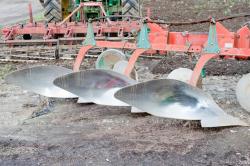
On this site in 1837 John Deere built the first successful self-scouring steel plow, thereby making a significant contribution to the development of American agriculture. Dedicated by American Society of Agricultural Engineers 1976
In 1926, Ives Hall, the original Agricultural Engineering Building at The Ohio State University, Columbus, was designated as ASAE's first engineering landmark in honor of department founder and 18th president of ASAE Fredrick Walter Ives. Frederick W. Ives 1884 - 1924.
Ives Hall was on the corner of Neil and Woodruff Avenues from 1926 - 2002. This display has been constructed with brick from the original structure.

In 1892, John H. Froehlich, Froehlich, IA, Mounted A Gasoline Fueled Internal Combustion Engine On A Traction Geared Frame And Used It To Power A Threshing Machine. A Change In Power Source Had Begun On North American Farms. In 1892, The Case Co., Racine, Wi, Built An Experimental Gas Traction Engine. In 1898 A Patent Was Issued To The Van Duzen Co. Cincinnati, OH, For A Gasoline Traction Engine. Huber Mnfg., Marion, Oh, Bought This Patent In 1898 And Produced 30 Prototype Units. In 1902, Hart-Parr, Founded By Charles W. Hart And Charles H.
Innovations
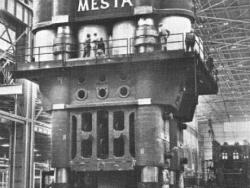
This 50,000-ton die-forging press is among the largest fabrication tools in the world. It was designed and built for the U.S. Air Force by the Mesta Machine Company of Pittsburgh, following the discovery of a 30,000-ton press used by the Germans in World War II (later acquired by the Soviet…
Read More
The Alaska Highway, initially called the Alaskan-Canadian (Alcan) Military Highway, provided an essential transportation link to the Yukon and Alaska during World War II. It begins at the junction with several Canadian highways in Dawson Creek, British Columbia and runs to Delta Junction, Alaska…
Read More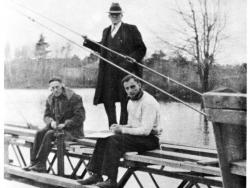
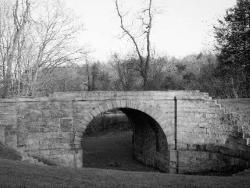
In an era when roads and canals were the most common means of overland transportation, the Allegheny Portage Railroad provided a novel alternative. The railway carried fully-loaded canal boats over the steep grades of the Allegheny Mountain. The 36-mile system rose almost 2,300 feet above sea…
Read More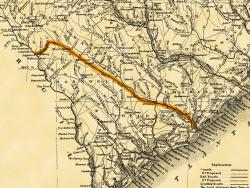
Built with a single set of tracks consisting of hardwood rails and wooden ties, and using wooden trestles to carry it over low-lying areas, the 136-mile Charleston-Hamburg Railroad was one of the longest railroads in the world when it was completed in 1833. It also became the first railroad in…
Read More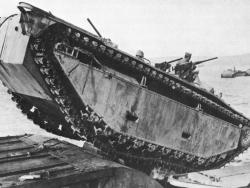
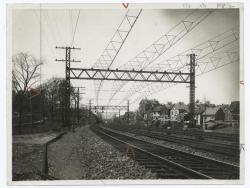
This was a pioneering venture in mainline railroad electrification. It established single-phase alternating current as a technical and economical alternative to direct current. This concept exerted considerable influence over subsequent systems both in the United States and abroad. The major…
Read More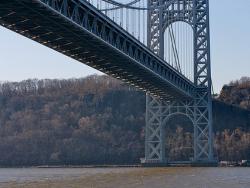
"An essential part of the human experience is to create an aesthetic atmosphere."
The George Washington Bridge represented a departure in suspension bridge design. Chief Engineer O.H. Ammann developed a system of stiffening trusses that offered greater flexibility and saved the project…
Read More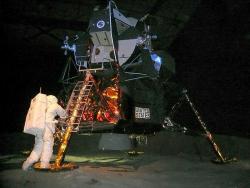
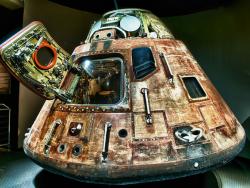
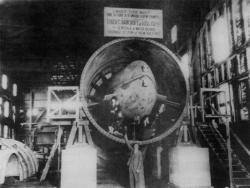
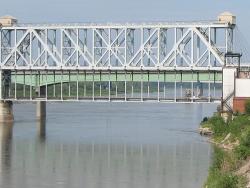
Work began in 1887 on the high-level truss "Winner Bridge" crossing the Missouri River at Kansas City. The piers were completed in 1890, but for financial reasons the project was suspended. John Alexander Low Waddell, renowned civil engineer, prepared an alternate design for a lift bridge in…
Read More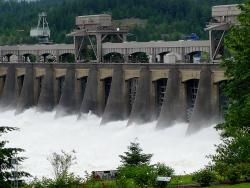
The Bonneville Dam, Columbia River Power and Navigation System consists of 55 major projects on Oregon's Columbia River and is said to be the largest hydroelectric system in the world.
The Columbia River forms part of the border between Washington and Oregon and flows inland through the…
Read More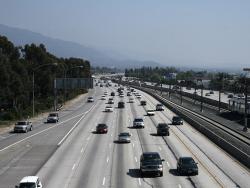
With its landscaped embankments, limited access, and depressed roadway, Arroyo Seco Parkway (now known as the Pasadena Freeway) became the prototype of the Los Angeles freeway system. Motorists enjoy a scenic drive featuring landscaped embankments lush with native chaparral. The curving…
Read More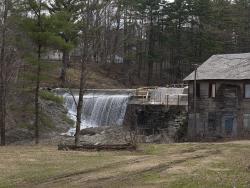
Ithamar A. Beard, an engineer of some prominence in New England, surveyed the mill brook and selected the best site for a storage dam. Contractor Simeon Cobb, knowledgeable of contemporary civil engineering practices, made major changes to the dam's original design, converting the linear dam…
Read More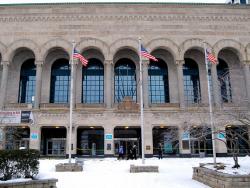
The quantities of materials used in the building are staggering: 12,000 tons of structural steel; 42,000 cubic yards of concrete - consisting of 65,000 barrels of cement and 25,000 tons of sand; 360,000 feet of piling; and 10,000,000 bricks. At the time of its construction, Atlantic City…
Read More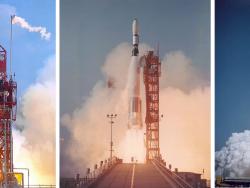

Hardy fishermen and their families have long inhabited Bailey Island, which was settled in the 1720s. Ordinarily, they did not mind crossing to the mainland in their fishing boats. But before the Bailey Island Bridge was built, during certain seasons of the year when violent storms battered the…
Read More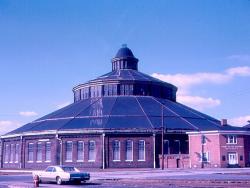
Read More"The roundhouse is an amazing survivor of an important era in American engineering and architectural history. Eric DeLony, chief of the National Park Service's Historic American Engineering Record, has called it 'the most important surviving cast-iron framed building in North…
